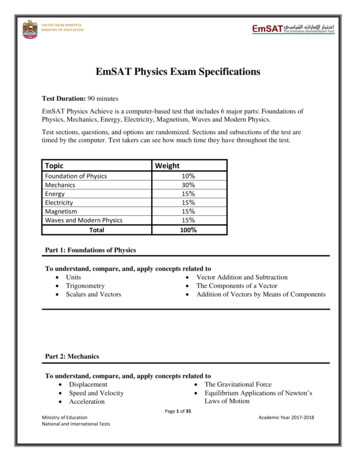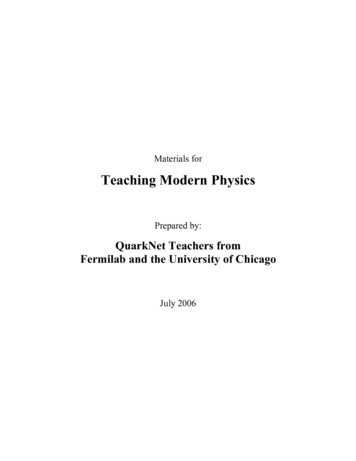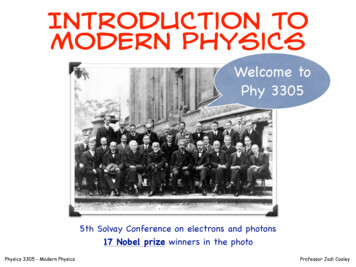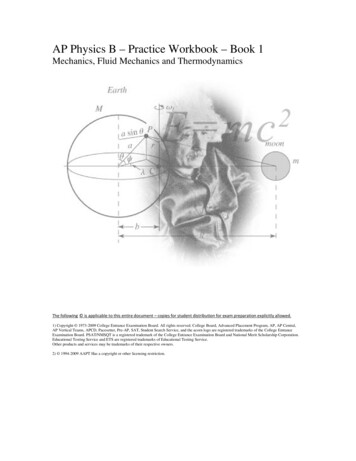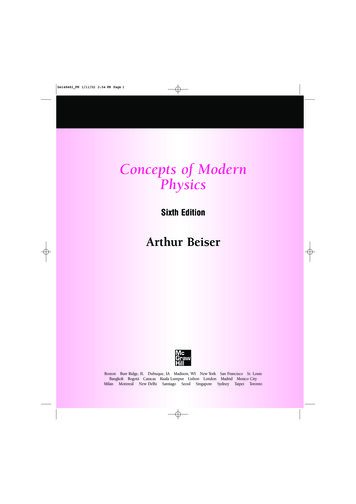
Transcription
bei48482 FM 1/11/02 2:54 PM Page iConcepts of ModernPhysicsSixth EditionArthur BeiserBoston Burr Ridge, IL Dubuque, IA Madison, WI New York San Francisco St. LouisBangkok Bogotá Caracas Kuala Lumpur Lisbon London Madrid Mexico CityMilan Montreal New Delhi Santiago Seoul Singapore Sydney Taipei Toronto
bei48482 fm.qxd 4/8/03 20:42 Page ii RKAUL-7 Rkaul-07:Desktop Folder:bei:McGraw-Hill Higher EducationA Division of The McGraw-Hill CompaniesCONCEPTS OF MODERN PHYSICS, SIXTH EDITIONPublished by McGraw-Hill, a business unit of The McGraw-Hill Companies, Inc., 1221Avenue of the Americas, New York, NY 10020. Copyright 2003, 1995, 1987, 1981,1973, 1967, 1963 by The McGraw-Hill Companies, Inc. All rights reserved. No part ofthis publication may be reproduced or distributed in any form or by any means, or storedin a database or retrieval system, without the prior written consent of The McGraw-HillCompanies, Inc., including, but not limited to, in any network or other electronic storageor transmission, or broadcast for distance learning.Some ancillaries, including electronic and print components, may not be available to customersoutside the United States.This book is printed on acid-free paper.InternationalDomestic1 2 3 4 5 6 7 8 9 0 VNH/VNH 0 9 8 7 6 5 4 3 22 3 4 5 6 7 8 9 0 VNH/VNH 0 9 8 7 6 5 4 3ISBN 0–07–244848–2ISBN 0–07–115096–X (ISE)Publisher: Kent A. PetersonSponsoring editor: Daryl BruflodtDevelopmental editor: Mary E. HaasMarketing manager: Debra B. HashSenior project manager: Joyce M. BerendesSenior production supervisor: Laura FullerCoordinator of freelance design: Rick D. NoelInterior design: Kathleen TheisCover design: Joshua Van DrakeCover image: Courtesy of Brookhaven National Laboratory, Soleniodal Tracker At RHIC (STAR)Experiment. Image: First Gold Beam-Beam Collision Events at Relativistic Heavy Ion Collider.Senior photo research coordinator: Lori HancockPhoto research: Chris Hammond/Photo Find LLCSenior supplement producer: Tammy JuranCompositor: TECHBOOKSTypeface: 10/12 Berkley Old StylePrinter: Von Hoffmann Press, Inc.The credits section for this book begins on page 529 and is considered an extension of thecopyright page.Library of Congress Cataloging-in-Publication DataBeiser, Arthur.Concepts of modern physics. — 6th ed. / Arthur Beiserp.cm.Includes index.ISBN 0–07–244848–21. Physics. II. Title.QC21.3 .B45 20032001044743CIPINTERNATIONAL EDITION ISBN 0–07–115096–XCopyright 2003. Exclusive rights by The McGraw-Hill Companies, Inc., for manufactureand export. This book cannot be re-exported from the country to which it is sold by McGraw-Hill.The International Edition is not available in North America.www.mhhe.com
bei48482 FM 2/4/02 12:12 PM Page iiiContentsPrefacexiiCHAPTERRelativity111.1Special Relativity2All motion is relative; the speed of light in free space is the samefor all observers1.2 Time Dilation5A moving clock ticks more slowly than a clock at rest1.3 Doppler Effect10Why the universe is believed to be expanding1.4 Length Contraction15Faster means shorter1.5 Twin Paradox17A longer life, but it will not seem longer1.6 Electricity and Magnetism19Relativity is the bridge1.7 Relativistic Momentum22Redefining an important quantity1.8 Mass and Energy262Where E0 mc comes from1.9 Energy and Momentum30How they fit together in relativity1.10 General Relativity33Gravity is a warping of spacetimeAPPENDIX I: The Lorentz Transformation37APPENDIX II: Spacetime46iii
bei48482 FM 1/11/02 2:54 PM Page ivivContentsCHAPTER2Particle Properties of Waves2.12.22.32.42.52.62.72.82.9Electromagnetic Waves53Coupled electric and magnetic oscillations that move with the speed oflight and exhibit typical wave behaviorBlackbody Radiation57Only the quantum theory of light can explain its originPhotoelectric Effect62The energies of electrons liberated by light depend on the frequencyof the lightWhat Is Light?67Both wave and particleX-Rays68They consist of high-energy photonsX-Ray Diffraction72How x-ray wavelengths can be determinedCompton Effect75Further confirmation of the photon modelPair Production79Energy into matterPhotons and Gravity85Although they lack rest mass, photons behave as though they havegravitational massCHAPTER3Wave Properties of Particles3.13.23.33.43.55292De Broglie Waves93A moving body behaves in certain ways as though it has a wave natureWaves of What?95Waves of probabilityDescribing a Wave96A general formula for wavesPhase and Group Velocities99A group of waves need not have the same velocity as the wavesthemselvesParticle Diffraction104An experiment that confirms the existence of de Broglie waves
bei48482 FM 1/11/02 2:54 PM Page vContents3.63.73.83.9Particle in a Box106Why the energy of a trapped particle is quantizedUncertainty Principle I108We cannot know the future because we cannot know the presentUncertainty Principle II113A particle approach gives the same resultApplying the Uncertainty Principle114A useful tool, not just a negative statementCHAPTER4Atomic Structure1194.1The Nuclear Atom120An atom is largely empty space4.2 Electron Orbits124The planetary model of the atom and why it fails4.3 Atomic Spectra127Each element has a characteristic line spectrum4.4 The Bohr Atom130Electron waves in the atom4.5 Energy Levels and Spectra133A photon is emitted when an electron jumps from one energy level to alower level4.6 Correspondence Principle138The greater the quantum number, the closer quantum physics approachesclassical physics4.7 Nuclear Motion140The nuclear mass affects the wavelengths of spectral lines4.8 Atomic Excitation142How atoms absorb and emit energy4.9 The Laser145How to produce light waves all in stepAPPENDIX: Rutherford Scattering152CHAPTER5Quantum Mechanics5.1160Quantum Mechanics161Classical mechanics is an approximation of quantum mechanicsv
bei48482 FM 1/11/02 2:54 PM Page viviContents5.2The Wave Equation163It can have a variety of solutions, including complex ones5.3 Schrödinger’s Equation: Time-Dependent Form166A basic physical principle that cannot be derived from anything else5.4 Linearity and Superposition169Wave functions add, not probabilities5.5 Expectation Values170How to extract information from a wave function5.6 Operators172Another way to find expectation values5.7 Schrödinger’s Equation: Steady-State Form174Eigenvalues and eigenfunctions5.8 Particle in a Box177How boundary conditions and normalization determine wave functions5.9 Finite Potential Well183The wave function penetrates the walls, which lowers the energy levels5.10 Tunnel Effect184A particle without the energy to pass over a potential barrier may stilltunnel through it5.11 Harmonic Oscillator187Its energy levels are evenly spacedAPPENDIX: The Tunnel Effect193CHAPTER6Quantum Theory of the Hydrogen Atom6.16.26.36.46.56.6Schrödinger’s Equation for the Hydrogen AtomSymmetry suggests spherical polar coordinatesSeparation of Variables203A differential equation for each variableQuantum Numbers205Three dimensions, three quantum numbersPrincipal Quantum Number207Quantization of energyOrbital Quantum Number208Quantization of angular-momentum magnitudeMagnetic Quantum Number210Quantization of angular-momentum direction200201
bei48482 FM 1/11/02 2:54 PM Page viiContents6.76.86.96.10Electron Probability Density212No definite orbitsRadiative Transitions218What happens when an electron goes from one state to anotherSelection Rules220Some transitions are more likely to occur than othersZeeman Effect223How atoms interact with a magnetic fieldCHAPTER7Many-Electron Atoms2287.1Electron Spin229Round and round it goes forever7.2 Exclusion Principle231A different set of quantum numbers for each electron in an atom7.3 Symmetric and Antisymmetric Wave Functions233Fermions and bosons7.4 Periodic Table235Organizing the elements7.5 Atomic Structures238Shells and subshells of electrons7.6 Explaining the Periodic Table240How an atom’s electron structure determines its chemical behavior7.7 Spin-Orbit Coupling247Angular momenta linked magnetically7.8 Total Angular Momentum249Both magnitude and direction are quantized7.9 X-Ray Spectra254They arise from transitions to inner shellsAPPENDIX: Atomic Spectra259CHAPTER8Molecules2668.1The Molecular Bond267Electric forces hold atoms together to form moleculesvii
bei48482 FM 1/11/02 2:54 PM Page viiiviiiContents8.28.38.48.58.68.78.8Electron Sharing269The mechanism of the covalent bondThe H2 Molecular Ion270Bonding requires a symmetric wave functionThe Hydrogen Molecule274The spins of the electrons must be antiparallelComplex Molecules276Their geometry depends on the wave functions of the outer electrons oftheir atomsRotational Energy Levels282Molecular rotational spectra are in the microwave regionVibrational Energy Levels285A molecule may have many different modes of vibrationElectronic Spectra of Molecules291How fluorescence and phsophorescence occurCHAPTER9Statistical Mechanics9.19.29.39.49.59.69.79.89.9296Statistical Distributions297Three different kindsMaxwell-Boltzmann Statistics298Classical particles such as gas molecules obey themMolecular Energies in an Ideal Gas3003They vary about an average of 2 kTQuantum Statistics305Bosons and fermions have different distribution functionsRayleigh-Jeans Formula311The classical approach to blackbody radiationPlanck Radiation Law313How a photon gas behavesEinstein’s Approach318Introducing stimulated emissionSpecific Heats of Solids320Classical physics fails againFree Electrons in a Metal323No more than one electron per quantum state
bei48482 FM 1/11/02 2:54 PM Page ixContents9.109.11Electron-Energy Distribution325Why the electrons in a metal do not contribute to its specific heat exceptat very high and very low temperaturesDying Stars327What happens when a star runs out of fuelCHAPTERThe Solid 5Crystalline and Amorphous Solids336Long-range and short-range orderIonic Crystals338The attraction of opposites can produce a stable unionCovalent Crystals342Shared electrons lead to the strongest bondsVan der Waals Bond345Weak but everywhereMetallic Bond348A gas of free electrons is responsible for the characteristic propertiesof a metalBand Theory of Solids354The energy band structure of a solid determines whether it is a conductor,an insulator, or a semiconductorSemiconductor Devices361The properties of the p-n junction are responsible for the microelectronicsindustryEnergy Bands: Alternative Analysis369How the periodicity of a crystal lattice leads to allowed and forbidden bandsSuperconductivity376No resistance at all, but only at very low temperatures (so far)Bound Electron Pairs381The key to superconductivityCHAPTER11Nuclear Structure38711.1Nuclear Composition388Atomic nuclei of the same element have the same numbers of protonsbut can have different numbers of neutronsix
bei48482 FM 1/11/02 2:54 PM Page xxContents11.211.311.411.511.611.7Some Nuclear Properties392Small in size, a nucleus may have angular momentum and a magneticmomentStable Nuclei396Why some combinations of neutrons and protons are more stablethan othersBinding Energy399The missing energy that keeps a nucleus togetherLiquid-Drop Model403A simple explanation for the binding-energy curveShell Model408Magic numbers in the nucleusMeson Theory of Nuclear Forces412Particle exchange can produce either attraction or repulsionCHAPTER12Nuclear 912.10418Radioactive Decay419Five kindsHalf-Life424Less and less, but always some leftRadioactive Series430Four decay sequences that each end in a stable daughterAlpha Decay432Impossible in classical physics, it nevertheless occursBeta Decay436Why the neutrino should exist and how it was discoveredGamma Decay440Like an excited atom, an excited nucleus can emit a photonCross Section441A measure of the likelihood of a particular interactionNuclear Reactions446In many cases, a compound nucleus is formed firstNuclear Fission450Divide and conquerNuclear Reactors4542E0 mc
bei48482 FM 2/4/02 2:27 PM Page xiContents12.11Nuclear Fusion in Stars460How the sun and stars get their energy12.12 Fusion Reactors463The energy source of the future?APPENDIX: Theory of Alpha Decay468CHAPTER13Elementary teractions and Particles475Which affects whichLeptons477Three pairs of truly elementary particlesHadrons481Particles subject to the strong interactionElementary Particle Quantum Numbers485Finding order in apparent chaosQuarks489The ultimate constituents of hadronsField Bosons494Carriers of the interactionsThe Standard Model and Beyond496Putting it all togetherHistory of the Universe498It began with a bangThe Future501“In my beginning is my end.” (T. S. Eliot, Four Quartets)APPENDIXAtomic Masses507Answers to Odd-Numbered ExercisesFor Further StudyCreditsIndex529531525516xi
bei48482 FM 1/11/02 2:54 PM Page xiiPrefaceodern physics began in 1900 with Max Planck’s discovery of the role of energyquantization in blackbody radiation, a revolutionary idea soon followed byAlbert Einstein’s equally revolutionary theory of relativity and quantum theory of light. Students today must wonder why the label “modern” remains attached tothis branch of physics. Yet it is not really all that venerable: my father was born in1900, for instance, and when I was learning modern physics most of its founders, including Einstein, were still alive; I even had the privilege of meeting a number of them,including Heisenberg, Pauli, and Dirac. Few aspects of contemporary science—indeed,of contemporary life—are unaffected by the insights into matter and energy providedby modern physics, which continues as an active discipline as it enters its secondcentury.This book is intended to be used with a one-semester course in modern physics forstudents who have already had basic physics and calculus courses. Relativity andquantum ideas are considered first to provide a framework for understanding thephysics of atoms and nuclei. The theory of the atom is then developed with emphasison quantum-mechanical notions. Next comes a discussion of the properties of aggregates of atoms, which includes a look at statistical mechanics. Finally atomic nucleiand elementary particles are examined.The balance in this book leans more toward ideas than toward experimental methods and practical applications, because I believe that the beginning student is betterserved by a conceptual framework than by a mass of details. For a similar reason thesequence of topics follows a logical rather than strictly historical order. The merits ofthis approach have led to the extensive worldwide use of the five previous editions ofConcepts of Modern Physics, including translations into a number of other languages,since the first edition appeared nearly forty years ago.Wherever possible, important subjects are introduced on an elementary level, whichenables even relatively unprepared students to understand what is going on from thestart and also encourages the development of physical intuition in readers in whomthe mathematics (rather modest) inspires no terror. More material is included than caneasily be covered in one semester. Both factors give scope to an instructor to fashionthe type of course desired, whether a general survey, a deeper inquiry into selectedsubjects, or a combination of both.Like the text, the exercises are on all levels, from the quite easy (for practice andreassurance) to those for which real thought is needed (for the joy of discovery). Theexercises are grouped to correspond to sections of the text with answers to the oddnumbered exercises given at the back of the book. In addition, a Student SolutionsManual has been prepared by Craig Watkins that contains solutions to the oddnumbered exercises.Because the ideas of modern physics represented totally new directions in thoughtwhen first proposed, rather than extensions of previous knowledge, the story of theirdevelopment is exceptionally interesting. Although there is no room here for a full account, bits and pieces are included where appropriate, and thirty-nine brief biographies of important contributors are sprinkled through the text to help provide a human persepctive. Many books on the history of modern physics are available for thoseMxii
bei48482 FM 2/4/02 11:13 AM Page xiiiPrefacewho wish to go further into this subject; those by Abraham Pais and by Emilio Segré,themselves distinguished physicists, are especially recommended.For this edition of Concepts of Modern Physics the treatments of special relativity,quantum mechanics, and elementary particles received major revisions. In addition,numerous smaller changes and updates were made throughout the book, and severalnew topics were added, for instance Einstein’s derivation of the Planck radiation law.There is more material on aspects of astrophysics that nicely illustrate important elements of modern physics, which for this reason are discussed where relevant in thetext rather than being concentrated in a single chapter.Many students, although able to follow the arguments in the book, nevertheless mayhave trouble putting their knowledge to use. To help them, each chapter has a selection of worked examples. Together with those in the Solutions Manual, over 350 solutions are thus available to problems that span all levels of difficulty. Understandingthese solutions should bring the unsolved even-numbered exercises within reach.In revising Concepts of Modern Physics for the sixth edition I have had the benefit ofconstructive criticism from the following reviewers, whose generous assistance wasof great value: Steven Adams, Widener University; Amitava Bhattacharjee, The University of Iowa; William E. Dieterle, California University of Pennsylvania; Nevin D. Gibson,Denison University; Asif Khand Ker, Millsaps College; Teresa Larkin-Hein, AmericanUniversity; Jorge A. López, University of Texas at El Paso; Carl A. Rotter, West VirginiaUniversity; and Daniel Susan, Texas A&M University–Kingsville. I am also grateful to thefollowing reviewers of previous editions for their critical reviews and comments: DonaldR. Beck, Michigan Technological University; Ronald J. Bieniek, University of Missouri–Rolla;Lynn R. Cominsky, Sonoma State University; Brent Cornstubble, United States MilitaryAcademy; Richard Gass, University of Cincinnati; Nicole Herbot, Arizona State University; Vladimir Privman, Clarkson University; Arnold Strassenberg, State University of NewYork–Stony Brook; the students at Clarkson and Arizona State Universities who evaluatedan earlier edition from their point of view; and Paul Sokol of Pennsylvania State University who supplied a number of excellent exercises. I am especially indebted to CraigWatkins of Massachusetts Institute of Technology who went over the manuscript with ameticulous and skeptical eye and who checked the answers to all the exercises. Finally,I want to thank my friends at McGraw-Hill for their skilled and enthusiastic helpthroughout the project.Arthur Beiserxiii
bei48482 FM 1/11/02 2:54 PM Page xivConcepts of ModernPhysicsSixth Edition
bei48482 ch01.qxd 1/15/02 1:20 AM Page 1CHAPTER 1RelativityAccording to the theory of relativity, nothing can travel faster than light. Although today’s spacecraft canexceed 10 km/s, they are far from this ultimate speed limit.1.11.21.31.41.51.6SPECIAL RELATIVITYAll motion is relative; the speed of light in freespace is the same for all observersTIME DILATIONA moving clock ticks more slowly than a clockat restDOPPLER EFFECTWhy the universe is believed to be expandingLENGTH CONTRACTIONFaster means shorterTWIN PARADOXA longer life, but it will not seem longerELECTRICITY AND MAGNETISMRelativity is the bridge1.7RELATIVISTIC MOMENTUMRedefining an important quantity1.8MASS AND ENERGYWhere E0 mc2 comes from1.9ENERGY AND MOMENTUMHow they fit together in relativity1.10 GENERAL RELATIVITYGravity is a warping of spacetimeAPPENDIX I: THE LORENTZTRANSFORMATIONAPPENDIX II: SPACETIME1
bei48482 ch01.qxd 1/15/02 1:20 AM Page 22Chapter Onen 1905 a young physicist of twenty-six named Albert Einstein showed how measurements of time and space are affected by motion between an observer and whatis being observed. To say that Einstein’s theory of relativity revolutionized scienceis no exaggeration. Relativity connects space and time, matter and energy, electricityand magnetism—links that are crucial to our understanding of the physical universe.From relativity have come a host of remarkable predictions, all of which have beenconfirmed by experiment. For all their profundity, many of the conclusions of relativitycan be reached with only the simplest of mathematics.I1.1 SPECIAL RELATIVITYAll motion is relative; the speed of light in free space is the same for allobserversWhen such quantities as length, time interval, and mass are considered in elementaryphysics, no special point is made about how they are measured. Since a standard unitexists for each quantity, who makes a certain determination would not seem to matter—everybody ought to get the same result. For instance, there is no question of principleinvolved in finding the length of an airplane when we are on board. All we have to dois put one end of a tape measure at the airplane’s nose and look at the number on thetape at the airplane’s tail.But what if the airplane is in flight and we are on the ground? It is not hard to determine the length of a distant object with a tape measure to establish a baseline, asurveyor’s transit to measure angles, and a knowledge of trigonometry. When we measure the moving airplane from the ground, though, we find it to be shorter than it isto somebody in the airplane itself. To understand how this unexpected difference ariseswe must analyze the process of measurement when motion is involved.Frames of ReferenceThe first step is to clarify what we mean by motion. When we say that something ismoving, what we mean is that its position relative to something else is changing. Apassenger moves relative to an airplane; the airplane moves relative to the earth; theearth moves relative to the sun; the sun moves relative to the galaxy of stars (the MilkyWay) of which it is a member; and so on. In each case a frame of reference is part ofthe description of the motion. To say that something is moving always implies a specificframe of reference.An inertial frame of reference is one in which Newton’s first law of motion holds.In such a frame, an object at rest remains at rest and an object in motion continues tomove at constant velocity (constant speed and direction) if no force acts on it. Anyframe of reference that moves at constant velocity relative to an inertial frame is itselfan inertial frame.All inertial frames are equally valid. Suppose we see something changing its position with respect to us at constant velocity. Is it moving or are we moving? Supposewe are in a closed laboratory in which Newton’s first law holds. Is the laboratory moving or is it at rest? These questions are meaningless because all constant-velocity motionis relative. There is no universal frame of reference that can be used everywhere, nosuch thing as “absolute motion.”The theory of relativity deals with the consequences of the lack of a universal frameof reference. Special relativity, which is what Einstein published in 1905, treats
bei48482 ch01.qxd 1/15/02 1:20 AM Page 3Relativityproblems that involve inertial frames of reference. General relativity, published byEinstein a decade later, describes the relationship between gravity and the geometricalstructure of space and time. The special theory has had an enormous impact on muchof physics, and we shall concentrate on it here.Postulates of Special RelativityTwo postulates underlie special relativity. The first, the principle of relativity, states:The laws of physics are the same in all inertial frames of reference.This postulate follows from the absence of a universal frame of reference. If the lawsof physics were different for different observers in relative motion, the observers couldfind from these differences which of them were “stationary” in space and which were“moving.” But such a distinction does not exist, and the principle of relativity expressesthis fact.The second postulate is based on the results of many experiments:The speed of light in free space has the same value in all inertial frames ofreference.This speed is 2.998 108 m/s to four significant figures.To appreciate how remarkable these postulates are, let us look at a hypotheticalexperiment basically no different from actual ones that have been carried out in anumber of ways. Suppose I turn on a searchlight just as you fly past in a spacecraftat a speed of 2 108 m /s (Fig. 1.1). We both measure the speed of the light wavesfrom the searchlight using identical instruments. From the ground I find their speedto be 3 108 m /s as usual. “Common sense” tells me that you ought to find a speedof (3 2) 108 m/s, or only 1 108 m /s, for the same light waves. But you alsofind their speed to be 3 108 m/s, even though to me you seem to be moving parallelto the waves at 2 108 m/s.v 2 108 m/sc 3 108 m/sc 3 108 m/s(a)( b)Figure 1.1 The speed of light is the same to all observers.(c)3
bei48482 ch01.qxd 1/15/02 1:21 AM Page 44Chapter OneAlbert A. Michelson (1852–1931)was born in Germany but came to theUnited States at the age of two withhis parents, who settled in Nevada. Heattended the U.S. Naval Academy atAnnapolis where, after two years of seaduty, he became a science instructor.To improve his knowledge of optics,in which he wanted to specialize,Michelson went to Europe and studied in Berlin and Paris. Then he leftthe Navy to work first at the Case School of Applied Science inOhio, then at Clark University in Massachusetts, and finally atthe University of Chicago, where he headed the physics department from 1892 to 1929. Michelson’s speciality was highprecision measurement, and for many decades his successivefigures for the speed of light were the best available. He redefined the meter in terms of wavelengths of a particular spectralline and devised an interferometer that could determine thediameter of a star (stars appear as points of light in even themost powerful telescopes).Michelson’s most significant achievement, carried out in1887 in collaboration with Edward Morley, was an experimentto measure the motion of the earth through the “ether,” a hypothetical medium pervading the universe in which light waveswere supposed to occur. The notion of the ether was a hangover from the days before light waves were recognized as electromagnetic, but nobody at the time seemed willing to discardthe idea that light propagates relative to some sort of universalframe of reference.To look for the earth’s motion through the ether, Michelsonand Morley used a pair of light beams formed by a half-silveredmirror, as in Fig. 1.2. One light beam is directed to a mirroralong a path perpendicular to the ether current, and the othergoes to a mirror along a path parallel to the ether current. Bothbeams end up at the same viewing screen. The clear glass plateensures that both beams pass through the same thicknesses ofair and glass. If the transit times of the two beams are the same,they will arrive at the screen in phase and will interfere constructively. An ether current due to the earth’s motion parallelto one of the beams, however, would cause the beams to havedifferent transit times and the result would be destructive interference at the screen. This is the essence of the experiment.Although the experiment was sensitive enough to detect theexpected ether drift, to everyone’s surprise none was found.The negative result had two consequences. First, it showed thatthe ether does not exist and so there is no such thing as “absolute motion” relative to the ether: all motion is relative to aspecified frame of reference, not to a universal one. Second, theresult showed that the speed of light is the same for all observers, which is not true of waves that need a material mediumin which to occur (such as sound and water waves).The Michelson-Morley experiment set the stage for Einstein’s1905 special theory of relativity, a theory that Michelson himself was reluctant to accept. Indeed, not long before the flowering of relativity and quantum theory revolutionized physics,Michelson announced that “physical discoveries in the futureare a matter of the sixth decimal place.” This was a commonopinion of the time. Michelson received a Nobel Prize in 1907,the first American to do so.Mirror APath AGlass plateParallel lightfromsingle sourcePath BMirror BHalf-silvered mirrorvViewing screenFigure 1.2 The Michelson-Morley experiment.Hypotheticalether current
bei48482 ch01.qxd 1/15/02 1:21 AM Page 5RelativityThere is only one way to account for these results without violating the principle ofrelativity. It must be true that measurements of space and time are not absolute but depend on the relative motion between an observer and what is being observed. If I wereto measure from the ground the rate at which your clock ticks and the length of yourmeter stick, I would find that the clock ticks more slowly than it did at rest on the groundand that the meter stick is shorter in the direction of motion of the spacecraft. To you,your clock and meter stick are the same as they were on the ground before you took off.To me they are different because of the relative motion, different in such a way that thespeed of light you measure is the same 3 108 m/s I measure. Time intervals and lengthsare relative quantities, but the speed of light in free space is the same to all observers.Before Einstein’s work, a conflict had existed between the principles of mechanics,which were then based on Newton’s laws of motion, and those of electricity andmagnetism, which had been developed into a unified theory by Maxwell. Newtonianmechanics had worked w
The greater the quantum number, the closer quantum physics approaches classical physics 4.7 Nuclear Motion 140 The nuclear mass affects the wavelengths of spectral lines 4.8 Atomic Excitation 142 How atoms absorb and emit energy 4.9 The Laser 145 How to produce light waves all in step APPENDIX: Rutherf




